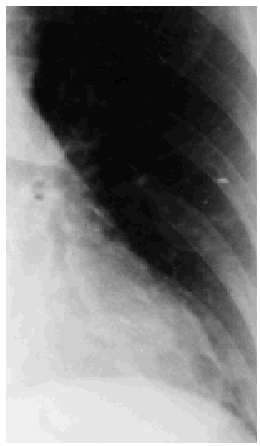To the editor: One of the complications that may arise when a contrast medium is applied by enema is venous embolism caused by barium intravasation into the venous system either from the colon (facilitated by the existing pathological condition) or from the vagina after tearing during accidental administration of the contrast medium there. The barium can be transported through the venous or portal circulation systems and the lungs and liver can act as filters, although barium may also pass through the lungs and enter other organs.
We report a case in which a contrast medium was accidentally placed in the patient's vagina and caused a tear, resulting in pulmonary embolism due to barium.
The patient was a 62 year-old woman who presented with exercise-related dyspnea, palpitations, and nausea. Her previous medical history only showed occasional use of salicylates for headaches.
The physical examination revealed blood pressure to be 140/70 mm Hg, temperature 36ºC; mucous membranes and skin were pallid. Cardiopulmonary auscultation and abdominal palpation gave normal results. The digital rectal examination showed dark stool (the patient was taking iron). The results of the complementary tests were as follows: leukocytes, 11x109/L; hematin, 2.08x1012/L; hemoglobin 1.02 mmol/L; hematocrit, 19%; mean corpuscular volume, 66 fL; mean corpuscular hemoglobin, 0.31 pg; platelets, 191x109/L; red blood cell sedimentation rate, 25 mm; glucose, 6.1 mmol/L; cholesterol, 4.4 mmol/L; triglycerides, 1.12 g/L; urea, 8.6 mmol/L; creatinine, 44.2 mmol/L; total proteins, 54 g/L; albumin, 39 g/L; total bilirubin, 17.1 mmol/L; calcium, 2.0 mmol/L; sodium, 147 mmol/L; potassium, 3.8 mmol/L; lactate dehydrogenase, 360 U/L; glutamic pyruvic transaminase, 20 U/L; glutamic oxalic transaminase, 24 U/L; gamma glutamyl transferase 11 U/L; alkaline phosphatase, 140 U/L; amylase, 106 U/L; iron, 1.8 µg/L; ferritin, 5 µg/L. The result of the analysis for blood in feces was positive.
A chest x-ray gave normal results. A gastroscopy was carried out and showed acute erosive duodenitis.
Following diagnosis of iron-deficiency anemia a barium enema examination was carried out and the contrast medium was accidentally administered into the vagina, which tore at the side. The fluoroscopy showed venous intravasation of barium. The examination was discontinued and a chest x-ray revealed pulmonary barium embolization (Figure). The patient complained of dizziness and had signs of hypotension and shivering, followed by fever of 38ºC. The symptoms abated after administration of intravenous antibiotics and the vaginal tear was repaired surgically. The results of analysis at this time were prothrombin time 100%; activated partial thromboplastin time 30/30 s; fibrinogen, 2.56 g/L; positive for fibrinogen degradation products (80 µg/mL); platelets, 149x109/L. Tests for barium in the blood and urine were negative.
Figure. Amplified image showing a barium particle in greater detail.
On entering the circulatory system barium may cause shivering, fever, prolonged hypotension or shock, and disseminated intravascular coagulation, all produced by the sepsis when material enters with the barium. Cultures of barium samples grow colonies of Escherichia coli, Pseudomonas aeruginosa, and Aerobacter and Flavobacterium sp. as well as very high concentrations of endotoxin. This may activate the tissue factor and consequently the kallikrein-kinin system. Barium in vitro causes the production of bradykinin,1 which contributes to the before-mentioned effects.
Although soluble barium salts are absorbed by the digestive tract and enter the circulatory system producing hypokalemia, cardiac arrythmia,2,3 and renal failure,4 barium sulfate is not absorbable or soluble and does not have such toxic effects. When barium reaches the lungs it can cause a clinical picture of pulmonary embolism with dyspnea, tachypnea, cough, or acute pulmonary edema. Barium can be detected in the liver and the lungs by simple x-ray and also by computed tomography.5 The mortality rate for this condition is high: of the 17 cases we reviewed in the literature, 10 ended in death. The condition was more serious when systemic circulation was affected, with death occurring in 8 patients out of 11, as opposed to 1 patient out of 6 when portal circulation was affected. The mortality rate may also have depended on the quantity of barium particles involved, as in surviving patients the amount of barium that entered the circulatory system was less than 5 mL.5,6 In surviving patients barium can be detected in images of the affected organs up to several months later, even when the patient feels well. In the case we describe barium was still being detected on chest x-rays some 7 months after the accident although the particles were smaller and had decreased in number; one of them even seemed to be forming a granuloma.
Autopsies performed on patients who have died have shown swollen Kupffer cells and endothelial cells in various organs, and inspection of cells under an electron microscope has revealed uniformly electrodense granules of various sizes. It therefore seems that barium is in part purified by the reticuloendothelial system.
Little is known about how to treat this condition because of the scarcity of reported cases. Given the pathogenesis of the process we propose the early administration of antibiotics that combat intestinal flora. If hypotension or shock and disseminated intravascular coagulation appear, they can be corrected using intravenous fluids, inotropic drugs, and the usual measures taken in these situations. Surgical repair of lesions should not be delayed.











